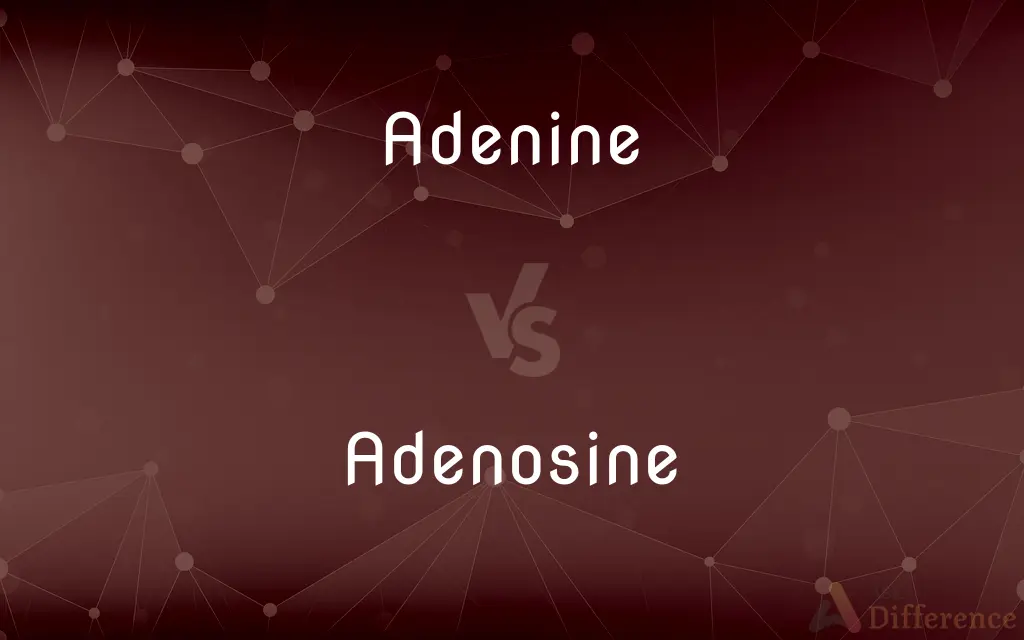Adenine vs. Adenosine — What's the Difference?
By Tayyaba Rehman — Updated on October 30, 2023
Adenine is a nitrogenous base, a building block of DNA and RNA; Adenosine is a nucleoside, a molecule formed when adenine attaches to a sugar (ribose).

Difference Between Adenine and Adenosine
Table of Contents
ADVERTISEMENT
Key Differences
Adenine is a purine base with a nitrogenous structure, essential in the formation of DNA and RNA. Adenosine, on the other hand, is a combination of adenine attached to a ribose sugar, forming a nucleoside. This additional sugar distinguishes adenosine from the simpler structure of adenine.
In the realm of genetics, adenine pairs with thymine in DNA and with uracil in RNA, playing a vital role in encoding genetic information. Adenosine, meanwhile, is involved in various biochemical processes, including energy transfer as part of ATP and signaling in the form of cAMP.
Adenine serves as a fundamental component of nucleotides, which are the building blocks of nucleic acids. Adenosine acts as an intermediate in various metabolic processes, extending its function beyond genetic encoding to include energy metabolism and signal transduction.
While adenine is integral in forming nucleotides, it doesn't directly participate in energy metabolism. Adenosine, however, is a core component of adenosine triphosphate (ATP), the primary energy currency of the cell, demonstrating its crucial role in energy transfer.
Adenine's primary significance lies in its genetic role. Adenosine has broader implications, influencing physiological processes such as sleep regulation, cardiac function, and inflammation through its role as a neurotransmitter and signaling molecule.
ADVERTISEMENT
Comparison Chart
Chemical Classification
Nitrogenous base
Nucleoside
Molecular Composition
Single molecule
Adenine + Ribose sugar
Role in Genetics
Forms part of DNA/RNA
Not directly involved in genetic encoding
Energy Metabolism
Not involved
Component of ATP
Physiological Function
Limited to genetic encoding
Wide-ranging, including signaling and energy transfer
Compare with Definitions
Adenine
Adenine is one of the four nitrogenous bases in DNA.
Adenine pairs with thymine in the DNA double helix.
Adenosine
Adenosine is a nucleoside composed of adenine and ribose.
Adenosine plays a role in various biochemical processes beyond genetics.
Adenine
Adenine is a constituent of adenosine triphosphate (ATP).
The adenine in ATP plays a crucial role in energy transfer within cells.
Adenosine
Adenosine acts in cAMP, involved in signal transduction.
Adenosine contributes to the regulation of cellular responses through cAMP.
Adenine
Adenine is a purine base, characterized by its double-ring structure.
As a purine, adenine has a more complex structure than pyrimidines.
Adenosine
Adenosine functions as a neurotransmitter in the nervous system.
The presence of adenosine can induce feelings of drowsiness.
Adenine
Adenine is a fundamental component of RNA, pairing with uracil.
In RNA transcription, adenine pairs with uracil instead of thymine.
Adenosine
Adenosine has roles in sleep, heart rate, and inflammation.
Adenosine's influence on heart rate is exploited in treating certain cardiac conditions.
Adenine
Adenine mutations can lead to genetic variations.
A mutation in the adenine base can result in genetic disorders.
Adenosine
Adenosine is part of ATP, essential for energy transfer.
Cells use adenosine-based ATP for energy in various metabolic activities.
Adenine
Adenine (A, Ade) is a nucleobase (a purine derivative). It is one of the four nucleobases in the nucleic acid of DNA that are represented by the letters G–C–A–T. The three others are guanine, cytosine and thymine.
Adenosine
Adenosine is an organic compound that occurs widely in nature in the form of diverse derivatives. The molecule consists of an adenine attached to a ribose via a β-N9-glycosidic bond.
Adenine
A purine base, C5H5N5, that is the constituent involved in base pairing with thymine in DNA and with uracil in RNA.
Adenosine
A nucleoside, C10H13N5O4, that is composed of adenine linked to ribose, is a component of nucleic acids and of ADP, AMP, and ATP, and plays a role in regulating various physiological functions.
Adenine
A base, C5H5N5, found in certain glands and tissues, which pairs with thymine in DNA and uracil in RNA.
Adenosine
A nucleoside derived from adenine and ribose, found in striated muscle tissue.
Adenine
(biochemistry) purine base found in DNA and RNA; pairs with thymine in DNA and with uracil in RNA
Adenosine
(biochemistry) a nucleoside that is a structural component of nucleic acids; it is present in all living cells in a combined form as a constituent of DNA and RNA and ADP and ATP and AMP
Common Curiosities
How does adenosine function in the body?
Adenosine participates in energy transfer, signal transduction, and acts as a neurotransmitter.
Can adenosine influence sleep patterns?
Yes, adenosine can regulate sleep and wakefulness.
What is adenine?
Adenine is a nitrogenous base essential in the structure of DNA and RNA.
Does adenine directly participate in energy metabolism?
No, adenine itself does not participate directly in energy metabolism.
Are adenine and adenosine the same thing?
No, adenine is a nitrogenous base, while adenosine is a nucleoside comprising adenine and a sugar.
What role does adenosine play in the heart?
Adenosine can regulate heart rate and is used in treating some cardiac conditions.
Is adenine found in DNA or RNA?
Adenine is found in both DNA and RNA.
Can mutations in adenine cause genetic disorders?
Yes, mutations in adenine can lead to genetic variations and disorders.
Can adenosine act as a signaling molecule?
Yes, adenosine is involved in cellular signaling, particularly through cAMP.
Is adenosine involved in genetic encoding?
Adenosine itself isn't directly involved in genetic encoding.
Is adenosine a purine or pyrimidine?
Adenosine includes adenine, which is a purine base.
How does adenine pair in DNA?
Adenine pairs with thymine in DNA.
Are adenine and adenosine involved in ATP formation?
Adenosine, as part of ATP, is directly involved, while adenine as a base is indirectly involved.
Does adenosine have a role in the immune system?
Yes, adenosine can influence inflammatory responses.
What type of molecule is adenine?
Adenine is a nitrogenous base, specifically a purine.
Share Your Discovery

Previous Comparison
As vs. Like
Next Comparison
Keratin vs. KreatinAuthor Spotlight
Written by
Tayyaba RehmanTayyaba Rehman is a distinguished writer, currently serving as a primary contributor to askdifference.com. As a researcher in semantics and etymology, Tayyaba's passion for the complexity of languages and their distinctions has found a perfect home on the platform. Tayyaba delves into the intricacies of language, distinguishing between commonly confused words and phrases, thereby providing clarity for readers worldwide.














































